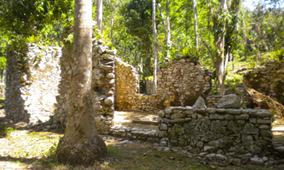Pinar del Río Coffee Plantation preserved
- Submitted by: admin
- Culture and Traditions
- Pinar del Río
- 07 / 11 / 2010

As testimony of an agricultural culture almost inexistent in other places of the world, the ruins in Cuba of coffee plantations set by French immigrants in the early 19th century, add a historical value to the beauty of the Rosario Range, in the western territory of Pinar del Rio.
Fugitive to the Island after the events of the Haitian Revolution, the Europeans fostered the growing of coffee in the mountains of the south-eastern region of the country and in that area of the west, 31,69 miles from Havana.
Some of these plantations are located in zones of present day Las Terrazas tourist resort.
After several centuries, remains of the coffee plantations are preserved there, where the visitors could notice the high specialization level they were designed with.
In those spots, along with vestiges of the original structure of the fields, they stand as mute witnesses of different agroindustrial techniques and samples of an architecture style similar to that incinerated by the Europeans before leaving Haiti.
Original elements of houses, plantations, trails, coffee pulping machines and dryers can be found there, since it is a constant concern of specialists interested on preserving that part of the Antillean history, which in this case rises among clouds in an amazingly beautiful space.
Outstanding turn out the ruins of the Buena Vista plantation that rises some 787,40 feet over the sea level with road access to its location; one of the best panoramic viewpoints of the Cuban west.
It is worth stressing that the prosperity achieved by the French encouraged those plantations in the mountains of Pinar del Rio, where some 60 estates of the epoch have been identified belonging to rich Cubans, Spanish and English.
The experts prioritize the study and restoration process, while make reference to other signs of French influence in constructions of Pinar del Rio city, as well as the tradition of gardening and the good taste for the fine arts.
Added to the coffee plantations located in the Biosphere Reserve of the Rosario Range, the country counts on other 191 created by that immigration flow in the provinces of Santiago de Cuba and Guantanamo, the latter with 32 estates recognized as the sixth Cuban point registered by the UNESCO as World Heritage Site.
Fugitive to the Island after the events of the Haitian Revolution, the Europeans fostered the growing of coffee in the mountains of the south-eastern region of the country and in that area of the west, 31,69 miles from Havana.
Some of these plantations are located in zones of present day Las Terrazas tourist resort.
After several centuries, remains of the coffee plantations are preserved there, where the visitors could notice the high specialization level they were designed with.
In those spots, along with vestiges of the original structure of the fields, they stand as mute witnesses of different agroindustrial techniques and samples of an architecture style similar to that incinerated by the Europeans before leaving Haiti.
Original elements of houses, plantations, trails, coffee pulping machines and dryers can be found there, since it is a constant concern of specialists interested on preserving that part of the Antillean history, which in this case rises among clouds in an amazingly beautiful space.
Outstanding turn out the ruins of the Buena Vista plantation that rises some 787,40 feet over the sea level with road access to its location; one of the best panoramic viewpoints of the Cuban west.
It is worth stressing that the prosperity achieved by the French encouraged those plantations in the mountains of Pinar del Rio, where some 60 estates of the epoch have been identified belonging to rich Cubans, Spanish and English.
The experts prioritize the study and restoration process, while make reference to other signs of French influence in constructions of Pinar del Rio city, as well as the tradition of gardening and the good taste for the fine arts.
Added to the coffee plantations located in the Biosphere Reserve of the Rosario Range, the country counts on other 191 created by that immigration flow in the provinces of Santiago de Cuba and Guantanamo, the latter with 32 estates recognized as the sixth Cuban point registered by the UNESCO as World Heritage Site.
By Elena Milian Salaberri
Source. Guerrillero
Comments